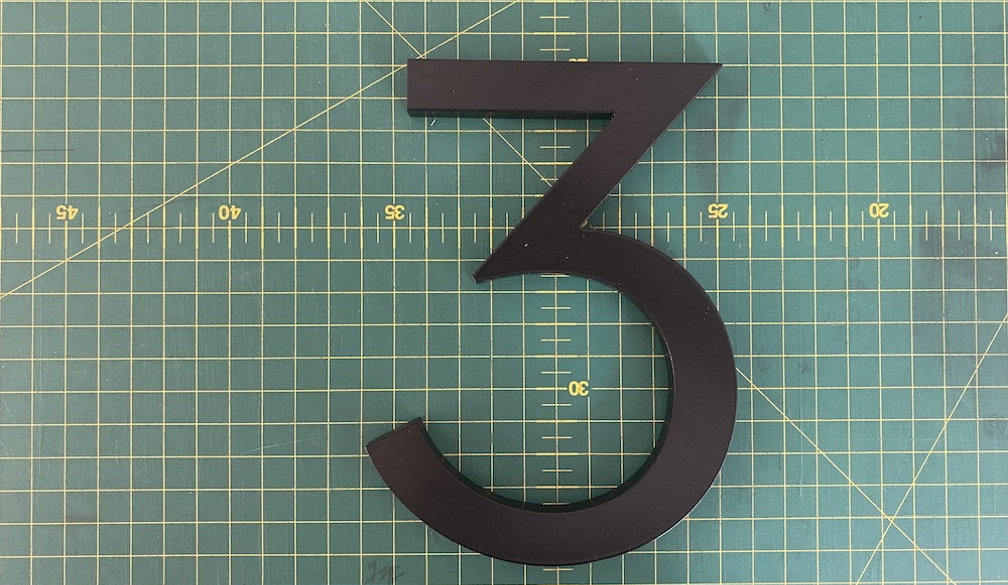Selecting the size of your house numbers
- Written by Simon McIntyre

What's in a number? Quite a bit, actually. The house number is one of the most crucial elements in the exterior design of your home. It's one of the primary things people notice when they walk up to your house, so it must quickly capture their attention. You can achieve this by making your house number visible; large house numbers are easier to see from a distance. Also, the numbers should match the overall design of your house. Additionally, house number material should go along with the material of where you are placing it.
Here are some ideas for choosing the right house number size if you're adding a new one or replacing an old one:
1. Decide How Big You Want Your House Numbers to Be
When deciding how big to make your house number, ensure it's easily visible from the street. You also want to make sure it's large enough to be legible from a distance.
Large house numbers are visible even for someone who is driving. You don't want your visitors to drive the entire street to locate your house.
On the other hand, if the numbers are too big, they can overpower your door and look like a billboard.
A good rule of thumb is to make the number at least 10cm high and use a contrasting colour that will be easy to see. You may also want to add a light or reflective material to make it more visible at night.
2. Consider the Font Style and Colour for Your House Number
When choosing a font style and colour for your house number, it's essential to consider the overall look of your house and neighbourhood. You want your house number to be easy to see and read from the street and match your home's style.
Most homeowners want their house numbers to look attractive. Although there are no hard-and-fast rules for selecting a font style, there are a few things to keep in mind.
Block letters are easy to read and work well with most home exteriors. Script fonts look elegant and can be a good choice if your home has a traditional style. Sans serif fonts are modern and minimalist, and they can be a good choice for contemporary homes.
Consider your home's theme colour and choose a colour that complements it when selecting a colour for your house number. Also, ensure that the colour you choose makes your house number stand out. The colour should also be visible at night.
3. Consider Your House Number Placement
When considering your house number size, think of where to place it. You want to make sure that it's visible from the street so that passers by can easily see it. Also, ensure that it's in a spot where emergency responders can find it quickly in case of an emergency.
Most people display house numbers near the front door, either on the door, on the wall, or at the top of the door frame. Also, the mailbox is an excellent place to display your house number. If you feel your house is too far from the street and it's hard for people to see it, you can place the number on your gate.
If you prefer to place the house number on the door and have a single door, it's good to put it on the centre door. Otherwise, set the number on the door most visitors use when entering the home on a two-door entry. Ensure that you place the number at the correct height, not too low nor too high.
It's essential to choose a spot that will be easy to find and visible no matter what time of day. It's also good to look up the rules and regulations of house numbers in your area.
4. Consider the Mounting Surface for Your House Number
When designing your house number, it's good to think of the mounting surface. The size of your house number should be proportional to the size of the wall you're mounting it on.
The size of the mounting surface largely determines the size of a house number. A number that is too large for the mounting surface can be distracting, and a number that is too small for the mounting surface can be hard to see from a distance.
Most house numbers are made to be mounted horizontally. However, you can mount your number on a vertical surface, especially with limited space. Ensure you secure the number well after mounting it onto the surface. Otherwise, the sign could fall off the wall easily.
If you're mounting the house numbers on your brick wall, for example, choose a bolder font so that it stands out against the brick.
Bottom Line
Consider the mounting surface, font style, colour, and display when selecting your house number size. You also want to ensure that the number is easy to see from the street.
It's essential to pick a size that complements your style, and remember to follow your local rules and regulations.
For a beautiful and long-lasting product, all of our numerals are made of 8mm thick solid premium aluminium with a choice of powder-coated black or white or brushed aluminium finish. Visit House Numbers for more details.

